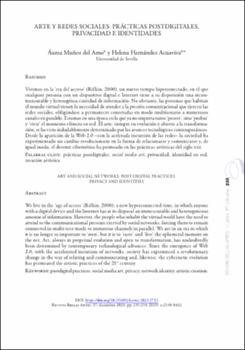Arte y redes sociales: prácticas postdigitales, privacidad e identidades
Date
2023Abstract
Vivimos en la ‘era del acceso’ (Rifkin, 2000), un nuevo tiempo hiperconectado, en el que
cualquier persona con un dispositivo digital e Internet tiene a su disposición una incon-
mensurable y heterogénea cantidad de información. No obstante, las personas que habitan
el mundo virtual tienen la necesidad de atender a la presión comunicacional que ejercen las
redes sociales, obligándose a permanecer conectadas en modo multiusuario a numerosos
canales en paralelo. Estamos en una época en la que ya no importa tanto ‘poseer’, sino ‘probar’
y ‘vivir’ el momento efímero en red. El arte, siempre en evolución y abierto a la transforma-
ción, se ha visto indudablemente determinado por los avances tecnológicos contemporáneos.
Desde la aparición de la Web 2.0 –con la acelerada incursión de las redes– la sociedad ha
experimentado un cambio revolucionario en la forma de relacionarse y comunicarse y, de
igual modo, el devenir cibernético ha permeado en las prácticas artísticas del siglo xxi. We live in the ‘age of access’ (Rifkin, 2000), a new hyperconnected time, in which anyone
with a digital device and the Internet has at its disposal an immeasurable and heterogeneous
amount of information. However, the people who inhabit the virtual world have the need to
attend to the communicational pressure exerted by social networks, forcing them to remain
connected in multi-user mode to numerous channels in parallel. We are in an era in which
it is no longer so important to ‘own’, but it is to ‘taste’ and ‘live’ the ephemeral moment on
the net. Art, always in perpetual evolution and open to transformation, has undoubtedly
been determined by contemporary technological advances. Since the emergence of Web
2.0, with the accelerated incursion of networks, society has experienced a revolutionary
change in the way of relating and communicating and, likewise, the cybernetic evolution
has permeated the artistic practices of the 21st century.





